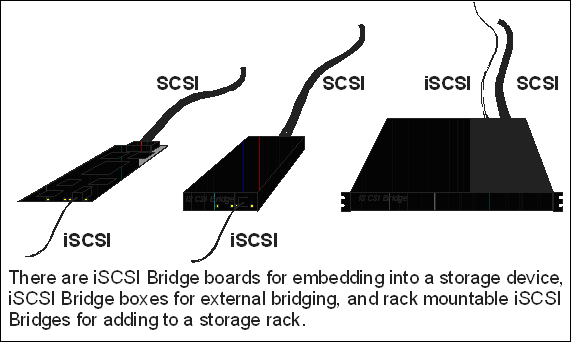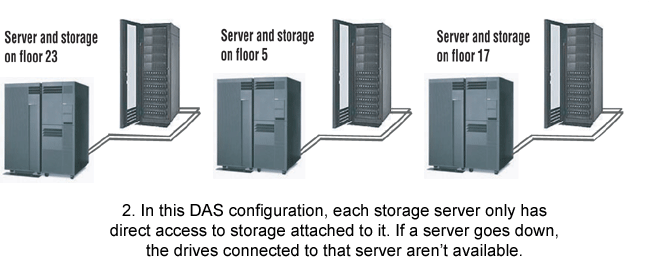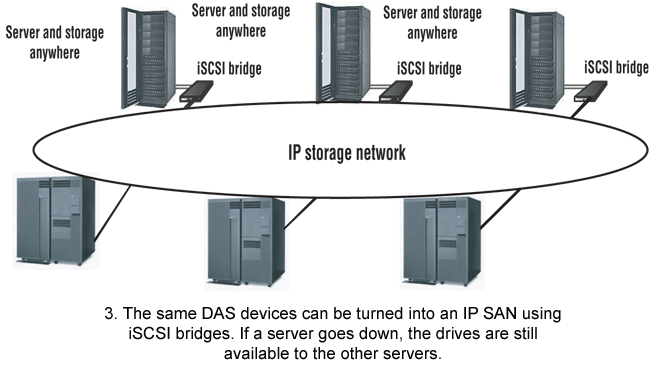iSCSI To SCSI Bridges Pave The Way To The Future The storage industry constantly faces the challenge of trying to manage ever increasing amounts of information efficiently and inexpensively. As a result, iSCSI-based IP storage-area networks (SANs) are rapidly gaining acceptance in the data-storage industry. And with it comes the need to have the massive base of existing parallel SCSI storage devices merged into the new iSCSI-based IP storage networks. It's hard to justify the expense of replacing those endless rows of SCSI tape drives, RAID packages, and other storage devices that work well but have parallel SCSI interfaces. Yet there's a solution available that can make those SCSI devices useable in the new iSCSI-based IP storage networks (Fig. 1, below).  The iSCSI to SCSI bridge can transparently attach the parallel SCSI devices to the new iSCSI network. The concept of bridging between two storage domains has been accepted in the storage industry since the late 1980s. SCSI to Fibre Channel bridges have been in use since the inception of Fibre Channel. In many cases, the bridges are embedded inside the Fibre Channel storage racks, providing Fibre Channel solutions using internal SCSI storage devices. IP SAN implementations based on iSCSI also can use parallel SCSI devices, using iSCSI to SCSI bridges. Lower Cost, Flexibility and Familiarity—iSCSI Has It All Fibre Channel SANs have been in existence for many years. But the cost of the hardware and administration learning curves have kept Fibre Channel from becoming the storage network of choice for small to mid-range businesses (SMBs). IP storage networks based on iSCSI reduce the cost of implementation to close to the cost of implementing direct attached storage (DAS) solutions. They also provide the SAN flexibility, ease of use, and connectivity that the SMBs have been looking for. Several companies currently offer parallel SCSI to Fibre Channel bridges. These bridges can range from $1500 to $10,000 in cost. The iSCSI interface is a lower-cost solution for network storage than Fibre Channel. Also, it provides the storage-network flexibility that traditional parallel SCSI lacks. Additionally, several companies provide iSCSI to SCSI bridges. On the average, the cost of an iSCSI to SCSI bridge is already lower than a Fibre Channel to SCSI bridge, with pricing in the $1000 to $5000 range. The iSCSI interfaces in the servers and the standard Ethernet switches and routers, which can be used to locate iSCSI devices anywhere, are also less expensive than their Fibre Channel counterparts. iSCSI Bridges Ease the Transition from DAS to IP SAN The relatively low cost and storage network flexibility of iSCSI, along with the already large infrastructure of IP-savvy and SCSI-savvy IT personnel, bodes well for iSCSI. A major influence in the growth of iSCSI will be how easy it is to merge with hardware and software that is already in use. It's hard to convince storage administrators that they need to replace all their hardware to improve the manageability and ease of growth in capacity of their current systems. It's much easier to add the capabilities of an iSCSI-based IP SAN to their current systems and have the ability to phase out the old when the time is right. With iSCSI bridges, administrators can add iSCSI storage network capabilities to current storage systems in whatever capacity is needed at the time, while allowing for growth into full-blown iSCSI storage environments in the future. Also, iSCSI bridges allow newly implemented IP storage networked systems to use and retain any SCSI-based storage devices that already may be available. And, iSCSI bridges enable the data storage provider to transform parallel SCSI storage offerings into IP SAN-ready storage. iSCSI bridges provide flexibility in configuring SANs to support the information storage requirements of any business. They help make it happen, from moving a single SCSI tape drive to a remote location using an iSCSI host adapter and an iSCSI bridge to having a complete iSCSI network environment, with all servers able to access all iSCSI devices, Fibre Channel devices, and parallel SCSI devices through the iSCSI-based IP storage network. Even if the industry goes to native embedded iSCSI storage devices in the future, there will still be a need to bridge between iSCSI storage networks and devices that do not have embedded iSCSI. A Simple Example Here is just one example of how the storage access changes when upgrading from SCSI to iSCSI. The SCSI-based disk arrays and backups currently in DAS configurations, directly attached to their respective storage servers, now can be upgraded to be incorporated into an iSCSI-based IP SAN. This permits those servers to all have direct access to all of the available storage devices. Storage access in the original DAS configuration has the servers on the system each have its storage and backup access, but without the ability for any server to directly address all of the storage devices (Fig. 2, below).  When the system is upgraded to an iSCSI SAN, it gives each storage server direct access to any storage device in the storage network. If one or more of the servers goes down for any reason, the data can still be accessed and used through any of the other servers still active on the IP storage network. The access to the storage is now much more flexible and easier to manage (Fig. 3, below).  Inside an iSCSI Bridge The iSCSI to SCSI bridge consists of several general building blocks: SCSI interface(s): The SCSI interface inside the bridge may be embedded on the iSCSI bridge pc board. Or, a standard SCSI interface card may be connected to the iSCSI bridge pc board through a PCI or PCI-X bus interface. Control module: The control module usually is a processor with an operating system and control software to manage the iSCSI communications between the SCSI and Ethernet ports. iSCSI interface(s): The iSCSI interface is an Ethernet network interface, with either built-in or software-controlled iSCSI and Ethernet communications protocols. It may be embedded on the iSCSI bridge pc board or also on a card connected to the iSCSI bridge pc board through a PCI or PCI-X bus interface. Configuration interface(s): The configuration interface may be a separate RS232, USB, or Ethernet port, or it may be handled directly through the iSCSI interface Ethernet port. It's used to configure all settings, software setups, and updates that the iSCSI bridge may need. It may have command line controls, all the way up to a built-in Web server on the more sophisticated iSCSI bridges. There are iSCSI bridges that bridge most of the storage interfaces in use today into iSCSI. SCSI, SAS, SATA, and Fibre Channel all have versions of iSCSI bridges available to allow their storage to be accessible in an iSCSI based IP Storage Network. iSCSI and iSCSI Bridges Are Here to Stay The growing iSCSI-based IP SAN industry has a future that will maintain its growth for the next decade. Because iSCSI works inside the TCP/IP Ethernet protocols, advances in Ethernet directly become advances in iSCSI. Ethernet is going to 10-Gbit speeds, with NIC cards already on the market that are competitive in price with Fibre Channel interfaces that communicate at much slower rates. iSCSI bridges also will be going to the 10-Gbit transfer speeds, guaranteeing that iSCSI-based IP SANs will be the performance leaders of the future. With price, performance, compatibility with other storage interfaces (through iSCSI bridges), and an industry-wide infrastructure of knowledgeable support, the iSCSI-based IP SAN will become the SAN of choice in the storage industry. For More Information Contact: Electronic Design Magazine, Web Site--http://www.elecdesign.com/ The Authority for Emerging Technologies for Design Solutions Marc D. Brooks is an active member of the STA and founder and CEO of Paralan Corporation, a manufacturer of SCSI bus enhancement products (Expanders), and iSCSI bridges. | |||||||||||||||||||||||||||||||
|
Paralan Corporation 4655 Ruffner Street, San Diego, CA 92111 Sales: (800) 479-7719 | Tel.: (858) 560-7266 | Fax: (858) 560-8929 | E-mail: info@paralan.com |
|||||||||||||||||||||||||||||||

Custom Search
|


